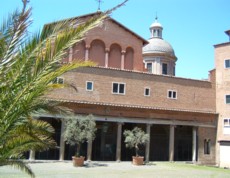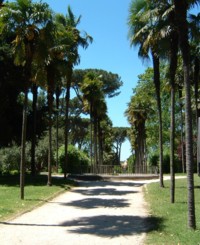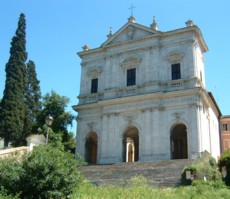The Celio, or Caelian Hill, is one of the famous seven hills of Rome. Much of Rome’s history seems to have passed it by, and it’s an atmospheric, unpopulated reminder of late imperial Rome.

The Celio hill was, and still is, divided in two sections by the Via Claudia. The lower eastern slopes, with narrow streets leading uphill to San Giovanni in Laterano, boasts three ancient churches: San Clemente, SS. Quattro Coronati and Santo Stefano Rotondo, as well as a selection of restaurants, bars and local shops. The western part is the most unusual and interesting destination, which seems to have developed little since the early Middle Ages.
In imperial times the Celio developed into an exclusive area where rich families lived in large villas with gardens. When the 17-year-old Emperor Nero came to the throne, he erected a temple on the Celio’s slopes dedicated to his predecessor, Claudius (in whose death he may have had a hand). Foundations and arches from the temple can still be seen to the west of the Via Claudia, just above the Colosseum.

A right turn (through an archway) off the Via Claudia, the Clivo Scauro (Clivus Scauri) is a narrow walled lane seemingly miles away from modern Rome. It still bears its Roman name, and the various changes that took place here more or less faded out in the Middle Ages. This part of the Celio was once dominated by the massive Temple of Claudius – huge building blocks from the temple complex can be seen scattered around the slopes above the Colosseum. The buildings and belltower adjacent to the Church of SS Giovanni e Paolo cover a corner of the temple. A large gateway to the right of the church, when open, allows you to get a good view of several tiers of the arched temple walls.
The church itself, dedicated to Saints John and Paul, was begun in the fourth century and modified many times since then. The interior now is an elegant eighteenth-century confection, lit by chandeliers, although plenty of evidence of the church’s history can also be seen. The site was the home of a Roman senator, who converted to Christianity and had his home turned into a place of worship. The church is closed at lunchtimes.
An elegant gateway off the little piazza opposite the church opens onto Villa Celimontana, one of Rome’s nicest parks.
Just past SS Giovanni e Paolo, a small doorway in the wall under the buttressing is the entrance to the Celio’s Case Romane – Roman houses. A series of rooms complete with frescoes remains underneath the present church; a reminder of earlier villas on this spot.

The road winds down to San Gregorio Magno, which has a tranquil courtyard concealed behind its tall Baroque facade. The monastery here, founded in the sixth century, was the base from which St. Augustine set out to bring Christianity to the wilds of Britain. To the right of San Gregorio Magno is a small dispensary, the Farmacia San Gregorio al Celio (open 10am-1pm, 3pm-6.30pm, closed Mondays). You can buy all sorts of monk-made products here, from hand creams to alcohol. The fruity blends of honey and jam are delicious.
You can reach the Celio on foot from the Colosseum or the Circo Massimo, and San Giovanni in Laterano. The most convenient bus is the 81, and the tram number 3 stops on the lower slopes of the hill, above the Colosseum. The nearest Metro stations are Circo Massimo and Colosseo.
On this site